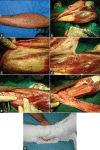Reverse peroneal artery flap for large defects of ankle and foot: A reliable reconstructive technique
- PMID: 22754152
- PMCID: PMC3385397
- DOI: 10.4103/0970-0358.96584
Reverse peroneal artery flap for large defects of ankle and foot: A reliable reconstructive technique
Abstract
Background: Large soft tissue defects around the lower third of the leg, ankle and foot always have been challenging to reconstruct. Reverse sural flaps have been used for this problem with variable success. Free tissue transfer has revolutionised management of these problem wounds in selected cases.
Materials and methods: Twenty-two patients with large defects around the lower third of the leg, ankle and foot underwent reconstruction with reverse peroneal artery flap (RPAF) over a period of 7 years. The mean age of these patients was 41.2 years.
Results: Of the 22 flaps, 21 showed complete survival without even marginal necrosis. One flap failed, where atherosclerotic occlusion of peroneal artery was evident on the table. Few patients had minor donor site problems that settled with conservative management.
Conclusions: RPAF is a very reliable flap for the coverage of large soft tissue defects of the heel, sole and dorsum of foot. This flap adds versatility in planning and execution of this extended reverse sural flap.
Keywords: Distally based peroneal flaps; extended reverse sural flaps; foot reconstruction; peroneal artery; reverse peroneal flaps.
Conflict of interest statement
Figures




Similar articles
-
Reverse Peroneal Artery Flap for Large Heel and Sole Defects: A Reliable Coverage.World J Plast Surg. 2017 May;6(2):212-219. World J Plast Surg. 2017. PMID: 28713713 Free PMC article.
-
The distally based sural flap for lower leg reconstruction: versatility in patients with associated morbidity.Ann Ital Chir. 2007 Jul-Aug;78(4):323-7. Ann Ital Chir. 2007. PMID: 17990610
-
Long-Term Clinical and Functional Outcomes of Distally Based Sural Artery Flap: A Retrospective Case Series.JPRAS Open. 2021 Jul 31;30:61-73. doi: 10.1016/j.jpra.2021.01.013. eCollection 2021 Dec. JPRAS Open. 2021. PMID: 34485662 Free PMC article.
-
How Safe Is Reverse Sural Flap?: A Systematic Review.Eplasty. 2022 Jun 3;22:e18. eCollection 2022. Eplasty. 2022. PMID: 35873071 Free PMC article. Review.
-
Exploring Reverse Sural Flap Necrosis in Lupus-like Syndrome: Challenges and Strategies in Lower Limb Reconstruction-A Case Presentation.Medicina (Kaunas). 2024 Dec 13;60(12):2053. doi: 10.3390/medicina60122053. Medicina (Kaunas). 2024. PMID: 39768932 Free PMC article. Review.
Cited by
-
Soft Tissue Tumors of Lower and Upper Limb and Various Reconstructive Options with Pedicled Flaps and Review of Literature-an Experience from Mahavir Cancer Sansthan.Indian J Surg Oncol. 2017 Sep;8(3):361-378. doi: 10.1007/s13193-017-0625-6. Epub 2017 Mar 2. Indian J Surg Oncol. 2017. PMID: 36118405 Free PMC article.
-
Distally based lateral supramalleolar flap for reconstructing distal foot defects in India: a prospective cohort study.J Trauma Inj. 2023 Sep;36(3):217-223. doi: 10.20408/jti.2023.0005. Epub 2023 Sep 18. J Trauma Inj. 2023. PMID: 39381696 Free PMC article.
-
Hemodynamics in Distally Based Sural Flaps for Lower Leg Reconstruction: A Literature Review.J Hand Microsurg. 2022 Jun 1;15(4):253-257. doi: 10.1055/s-0042-1749445. eCollection 2023 Sep. J Hand Microsurg. 2022. PMID: 37701313 Free PMC article. Review.
-
Peroneal artery injury potential due to different syndesmosis screw placement options: a simulation study with lower extremity computed tomography angiography.Arch Orthop Trauma Surg. 2024 May;144(5):2119-2125. doi: 10.1007/s00402-024-05258-w. Epub 2024 Mar 16. Arch Orthop Trauma Surg. 2024. PMID: 38492060 Free PMC article.
-
Reverse Peroneal Artery Flap-A Workhorse Flap for Reconstruction of Large, Distal Defects of Ankle and Foot.Indian J Plast Surg. 2023 Jan 20;55(4):383-390. doi: 10.1055/s-0042-1760091. eCollection 2022 Dec. Indian J Plast Surg. 2023. PMID: 36683885 Free PMC article.
References
-
- Benito-Ruiz J, Yoon T, Guisantes-Pintos E, Monner J, Serra-Renom JM. Reconstruction of soft tissue defects of the heel with local fasciocutaneous flaps. Ann Plast Surg. 2004;52:380–4. - PubMed
-
- Eren S, Ghofrani A, Reifenrath M. The distally pedicled peroneus brevis muscle flap: A new flap for the lower leg. Plast Reconstr Surg. 2001;107:1443–8. - PubMed
-
- Yang YL, Lin TM, Lee SS, Chang KP, Lai CS, Ruan HJ, Cai PH, et al. The extended peroneal artery perforator flap for lower extremity reconstruction. Ann Plast Surg. 2010;64:451–57. - PubMed
-
- The distally pedicled peroneus brevis muscle flap anatomic studies and clinical applications. J Foot Ankle Surg. 2005;44:259–64. - PubMed
-
- Donski PK, Fogdestam I. Distally based fasciocutaneous flap from the sural region: A preliminary report. Scand J Plast Reconstr Surg. 1983;17:191–6. - PubMed
LinkOut - more resources
Full Text Sources

